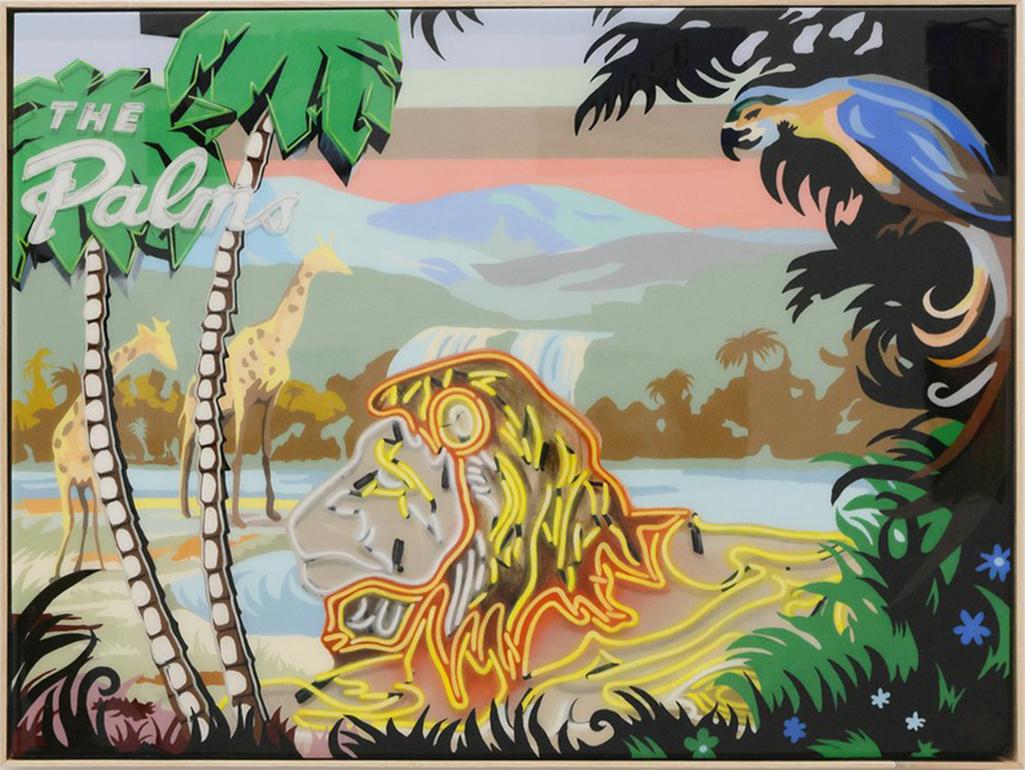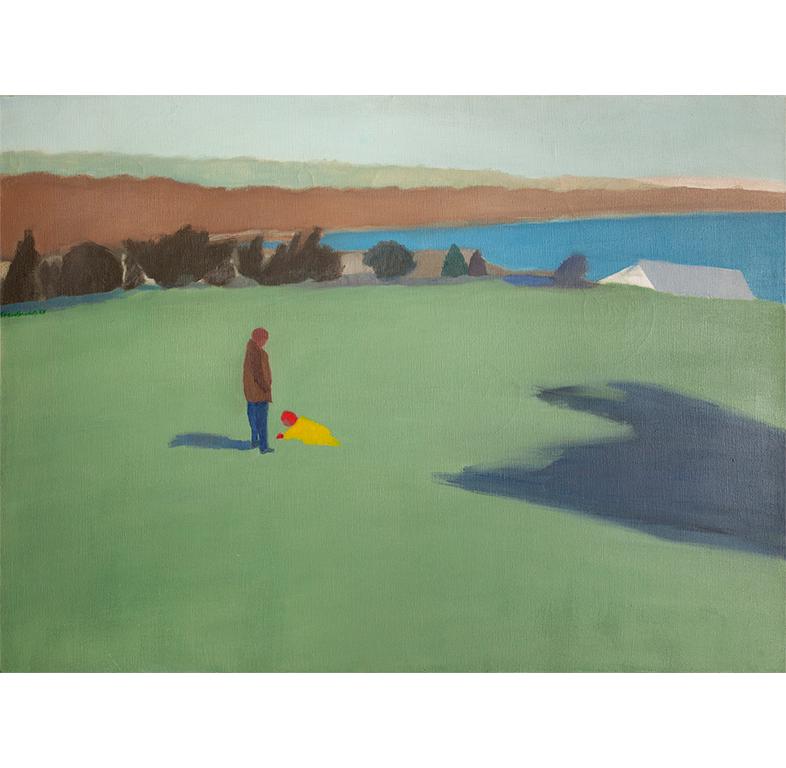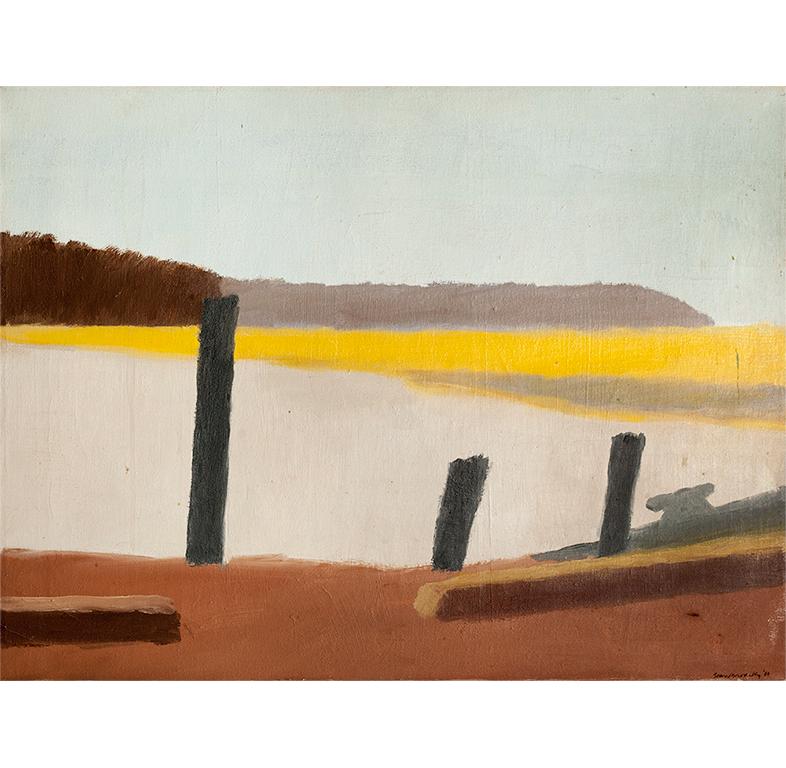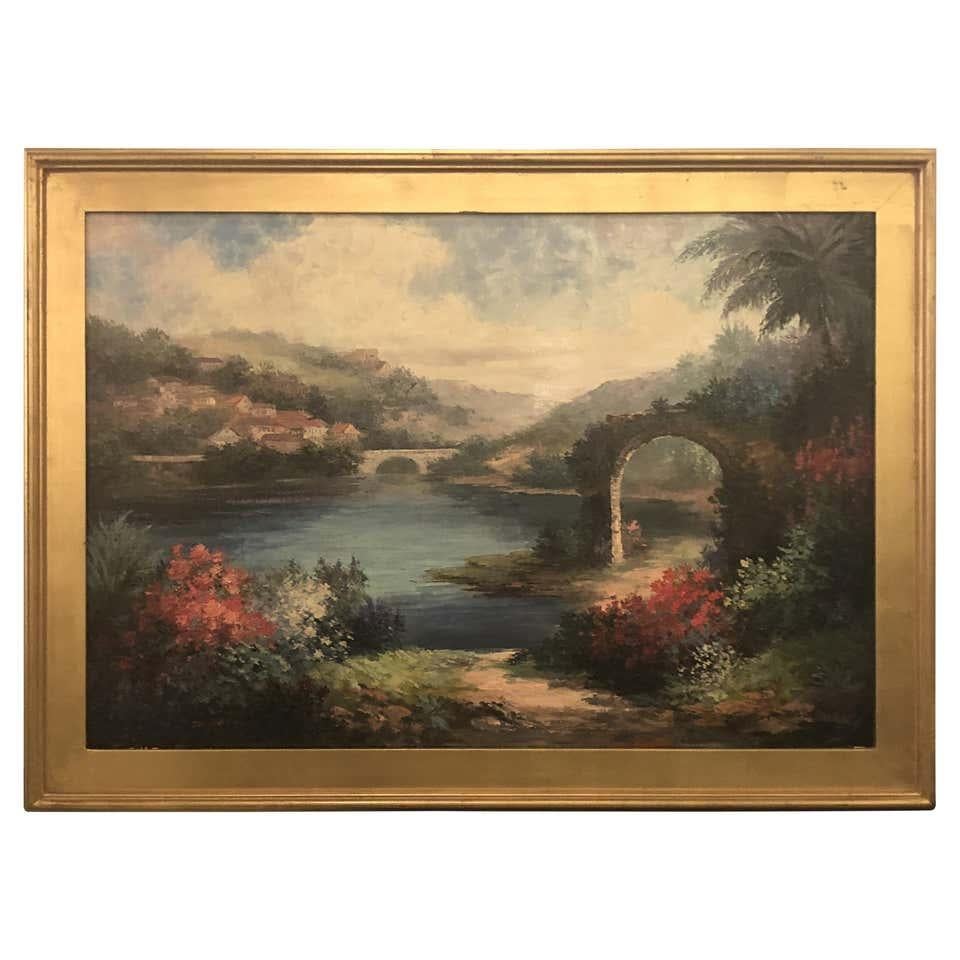Items Similar to Ponte Neuf (The Old Bridge)
Want more images or videos?
Request additional images or videos from the seller
1 of 5
David McCoshPonte Neuf (The Old Bridge)1928
1928
About the Item
(Note: This work is part of our exhibition Connected by Creativity: WPA Era Works from the Collection of Leata and Edward Beatty Rowan)
Oil on panel, 14 ½ x 18 inches unframed, 22 x 25 ½ inches framed, inscribed “painted by David McCosh Property of Edward b. Rowan” and numbered “8” verso
Exhibited:
The First Exhibit of the Iowa Artist’s Club at the Yonkers’ Tearoom, Des Moines, Iowa, in November 1929, and other Iowa locations in the following months, including in Ames, Cedar Rapids (at the Little Gallery), Davenport (at the Municipal Art Gallery), Dubuque (at the Public Library) and Iowa City (see The First Exhibit of the Iowa Artists’ Club, The Des Moines Register (Des Moines, Iowa) November 17, 1929 (this work is illustrated together with nine other paintings from the exhibition of fifty-six works); perhaps exhibited at McCosh’s solo exhibition at the Little Gallery, Cedar Rapids, Iowa, March, 1929 (see Rowan, Edward, Art News of the Little Gallery, The Gazette (Cedar Rapids, Iowa), March 7, 1929 – indicating that the exhibit consisted of fifteen paintings, most of which were completed in Europe and illustrating Pont Marie, Paris, a related composition which is in the collection of the Cedar Rapids Chamber of Commerce)
About the Artist:
David McCosh was born in 1903 in Cedar Rapids, Iowa. He was an important painter, muralist, and teacher. McCosh studied at Coe College, the Art Institute of Chicago, and the Art Students League. He won the Institute’s prestigious John Quincy Adams scholarship and painted in France in 1928. He returned to his native Iowa where he began close associations with Edward Rowan, the Little Gallery, and the Stone City Art Colony. In 1934, McCosh joined the Public Works of Art Program. After exhibiting his pieces and working throughout the Midwest and New York, McCosh accepted a teaching position at the University of Oregon in 1934, where he taught art for the next 36 years. McCosh received three mural commissions from the Treasury Department’s Section of Fine Arts. Many of McCosh’s works from the 1930s and early 1940s draw on American Scene traditions. His later art engaged more with the natural world, most often through an abstract lens. McCosh is listed in Who Was Who in American Art and all other standard references.
- Creator:David McCosh (1903 - 1980, American)
- Creation Year:1928
- Dimensions:Height: 14.5 in (36.83 cm)Width: 18 in (45.72 cm)
- More Editions & Sizes:22 x 25.5 framedPrice: $3,750
- Medium:
- Movement & Style:
- Period:
- Condition:
- Gallery Location:Los Angeles, CA
- Reference Number:1stDibs: LU1859212570292
About the Seller
No Reviews Yet
Vetted Seller
These experienced sellers undergo a comprehensive evaluation by our team of in-house experts.
1stDibs seller since 2022
6 sales on 1stDibs
Typical response time: 6 hours
- ShippingRetrieving quote...Ships From: Los Angeles, CA
- Return PolicyA return for this item may be initiated within 3 days of delivery.
More From This SellerView All
- Amish Farmscape #3By Edmund LewandowskiLocated in Los Angeles, CAAmish Farmscape #3, 1984, oil on canvas, 40 x 30 inches, signed and dated lower right; signed, dated, and titled verso About the Painting Amish Farmscape #3 is part of a multi-painting series of barns completed in the early 1980s for an exhibition at New York’s prestigious Sid Deutsch Gallery. Lewandowski painted this work at an important point in his career. It was the first major project undertaken by Lewandowski after his retirement from serving as the Chairman of Winthrop University’s Art Department, the last academic position he held after teaching for nearly thirty years. Lewandowski had been inspired to work on the series by a visit to Lancaster County, Pennsylvania. Like his friend and mentor, Charles Sheeler, Lewandowski had always been fascinated by vernacular architecture and the Amish barns of Pennsylvania brought back memories of rural scenes Lewandowski had painted in the Midwest much earlier in his career. Amish Farmscape #3 is a strong example of Lewandowski’s late precisionist work. The complexity of the composition and Lewandowski’s technical acumen are on full display. Being relieved of the burdens of teaching and administering a university art department likely allowed Lewandowski greater freedom and most importantly more time to complete the Amish Farmscape series. Although Lewandowski’s brand of precisionism changed throughout the years, he never deviated from the core tenets of the Immaculate School artists. In this work, we see simplified and flattened forms, the use of ray-lines to define light and space, the elimination of extraneous details, a polished almost machine-like finish, and the complete lack of visible brushstrokes, all hallmarks of the precisionist painters. Lewandowski was the last of the 20th century precisionists and in Amish Farmscape #3, we see just how successfully he continued to work in this style until his death in 1998. About the Artist Edmund Lewandowski was among the best of the second-generation precisionist painters. He was born and raised in Milwaukee, Wisconsin and studied at the Layton School of Art with Garrett Sinclair. Lewandowski achieved early success when in 1936 two of his watercolors were shown at the Phillips Collection as part of a Federal Art Project exhibition. Then, in 1937, his work was first exhibited at Edith Halpert’s Downtown Gallery which represented Lewandowski into the 1950s. Under Halpert’s guidance, Lewandowski continued to explore watercolor as his main medium during the 1930s and 1940s, since the gallery already represented Charles Sheeler, who worked primarily in oils. Sheeler became Lewandowski’s major influence as the primary leader of the ill-defined, but very recognizable Immaculate School artists, which included other Downtown Gallery painters, Niles Spencer, George Ault, and Ralston Crawford, as well as Charles Demuth and Preston Dickinson, both of whom died at a young age and had been represented by the Charles Daniel Gallery. Sheeler is credited with giving Lewandowski technical advice on how to make his paintings more precise and tightly rendered and by all accounts, Sheeler was a fan of Lewandowski’s work. Through the Downtown Gallery, Lewandowski’s paintings were accepted into major national and international exhibitions and purchased by significant museums and collectors. Franklin and Eleanor Roosevelt and Nelson Rockefeller acquired works by Lewandowski. He was included in the Museum of Modern Art’s important 1943 exhibition, American Realists and Magic Realists as well as juried exhibitions at the Whitney Museum of American Art, the Pennsylvania Academy of Fine Arts, and the Art Institute of Chicago. Lewandowski also completed commissions for magazines during the 1940s and 1950s, including several covers for Fortune. Throughout his career, Lewandowski explored urban and rural architecture, industry, machinery, and nautical themes. Looking back on his career, Lewandowski wrote, “My overwhelming desire as an artist through the years has been to record the beauty of man-made objects and energy of American industry on canvas. For as far back as I can recall, the cityscapes, farms and depictions of industrial power and technological efficiency has had a great attraction for me. I try to treat these observations with personal honesty and distill these impressions to a visual order.” Lewandowski is credited with extending precisionism to the Midwest and successfully continuing the style into the 1990s, three decades after Sheeler’s death and six decades after Demuth’s passing. Late in his career, Lewandowski enjoyed a resurgence of popularity as he was represented during the 1980s by New York’s Sid Deutsch and Allison Galleries...Category
Mid-20th Century American Modern Landscape Paintings
MaterialsCanvas, Oil
- Moonlight ShantiesLocated in Los Angeles, CAMoonlight Shanties, c. 1940s, oil on canvas, 24 x 18 inches, signed lower right, signed and titled verso About the Painting In Moonlight Shanties, Joachim depicts a lower-class neighborhood sitting along-side an elevated road or railway which crowds out the small nearby houses and structures. Joachim’s use of an expressionist palette and gestural brushstrokes together with the isolated figures obscured in the shadows, create a feeling of unease, isolation and even loneliness. From the 1920s through 1940s, American artists commonly employed expressionist conventions in their social realist works which portrayed the gritty side of urban America, especially the communities of the city-dwelling poor. Expressionist styles were considered appropriate for bridging the gap between the modernist idea of art-for-art’s-sake and the narrative qualities demanded by the dual crises of the Great Depression and World War II. Moonlight Shanties successfully uses these expressionist methods to portray a neighborhood and its people who appear to be literally and figuratively “on the edge.” About the Artist Paul Lamar Joachim...Category
1940s American Modern Landscape Paintings
MaterialsOil
- Abstract Street (Untitled)By Hananiah HarariLocated in Los Angeles, CAThis painting is part of our exhibition America Coast to Coast: Artists of the 1930s Abstract Street (Untitled), 1939, oil on canvas, signed and dated lower right, 12 x 32 inches; provenance includes a private collection in Venice, California; presented in what is likely the artist's original handmade frame About the Painting The present work is the culmination of a series of mainly horizontal urban abstractions Harari completed between 1937 and 1939. Deeply influenced by Stuart Davis, Harari’s New York streetscapes began with clearly recognizable objects and landmarks as in Into New York (1937 - Collection of the Whitney Museum of American Art), New York Harbor (1937), Up and Downtown (1938), and his other mural proposals for the Nurses Home on Welfare Island (1937) and the Williamsburg Housing Project (1938). At the end of the series, Harari’s vistas became increasingly abstract with broad planes of color representing buildings and streets, the slightest cross-hatching forming a bridge or elevated train track and the vague suggestion of a streetlight looping in the right center of the composition. Figures, birds, and a street vendor’s cart are reduced to pictograms scratched into the surface of the canvas. Abstract Street (Untitled) is among Harari’s most spare works of the 1930s and 1940s and calls to mind the seemingly childlike, but deeply sophisticated works of Paul Klee from the 1920s. It serves as an excellent reminder of why Harari was heralded as one of the earliest members of the American Abstract Artists. About the Artist Hananiah Harari was an artistic polyglot who was equally at home working in styles as diverse as Cubism, Constructivism, Expressionism, Hard Edged Abstraction and trompe l’oeil Realism. A native of Rochester, New York, Harari initially studied as a child at the Memorial Art Gallery in his hometown and later as a scholarship student at the College of Fine Arts at Syracuse University. In 1932, Harari left for Paris where he befriended Nahum Tschacbasov, Benjamin Benno and John Graham and studied at the ateliers of Lhote, Leger and Gromaire. He also studied fresco painting at the Ecole de Fresque. By 1933, Harari had completed enough work and gained a sufficient reputation to have a solo exhibition at the American Club in Paris. The following year, Harari and his childhood friend and fellow artist Herzl Emanuel traveled to Palestine, where the artists worked hard in the orchards and fields of Kibbutz Deganiah, but produced little art. After returning to New York, Harari married Emanuel’s sister, Freda, and set out on the development of what noted scholar Gail Stavitsky has called an “original synthesis of the old and new." Harari became an early member of the American Abstract Artists (AAA), an organization formed to give modernists exhibition opportunities. Harari was also a member of the socially conscious Artist’s Union and the American Artist’s Congress. From 1936 through 1942, Harari worked on the Federal Art Project and assisted Marion Greenwood on a project as part of the Mural Division, but to his disappointment did not lead his own project. During the late 1930s and early 1940s, Harari completed a series of paired paintings with the same subject matter depicted in a Cubist manner and in trompe l’oeil Realism. Harari was acclaimed by Clement Greenberg and six of the artist’s works were selected for the Museum of Modern Art’s important 1943 exhibition American Realists and Magic Realists. During World War II, Harari served in the US Army Air Corps. Following the war, Harari continued to produce fine art while also producing commercial art. During the McCarthy Era, Harari’s progressive politics and leftist leaning art...Category
1930s American Modern Abstract Paintings
MaterialsOil
- Jefferson Market Library (Courthouse)Located in Los Angeles, CAThis painting is part of our exhibition America Coast to Coast: Artists of the 1930s Jefferson Market Library (Courthouse), c. 1930s, oil on canvas, 30 x 24 inches, signed lower right; presented in a newer silver painted frame About the Painting Writing about an exhibition of Charles W. Adams’ work at the Eighth Street Art Gallery in the mid-1930s, Emily Grenauer observed in The World-Telegram that the artist’s paintings were “distinguished for their solid form, well organized design and sumptuous color” and the art critic for The Herald Tribune found Adam’s work “a strong, formal realization of his subject . . . he paints with vital emphasis on structure and composition.” Although we do not know which works these critics referenced, it is likely they were writing about paintings like Jefferson Market Library (Courthouse). With its carefully designed reality, strong angles, solid forms, and well-disciplined puffs of smoke in the background, Adams presents a highly structured version of the Greenwich Village landmark, the Jefferson Market Library, which was a courthouse at the time Adams completed this work. The Jefferson Market Library was a prized subject for downtown painters, including the Ashcan School painter, John Sloan, the modernist, Stuart Davis, and the precisionist, Francis Criss...Category
1930s American Modern Landscape Paintings
MaterialsOil
- Subway ConstructionLocated in Los Angeles, CAThis painting is part of our exhibition American Coast to Coast: Artists of the 1930s Subway Construction, c. 1928, oil on board, 19 x 15 ¾ inches, signed upper left, artist and title verso; exhibited: 1) 12th Annual Exhibition of the Society of Independent Artists, The Waldorf Astoria, New York NY, from March 9 to April 1, 1928, no. 864 (original price $250) (see Death Prevailing Theme of Artists in Weird Exhibits, The Gazette (Montreal, Quebec, Canada), March 8, 1928); 2) Boston Tercentenary Exhibition Fine Arts and Crafts Exhibition, Horticultural Hall, Boston MA, July, 1930, no. 108 (honorable mention - noted verso); 3) 38th Annual Exhibition of American Art, Cincinnati Art Museum, Cincinnati, OH, June, 1931 (see Alexander, Mary, The Week in Art Circles, The Cincinnati Enquirer, June 7, 1931); and 4) National Art Week Exhibition [Group Show], Montross Gallery, New York, New York, December, 1940 (see Devree, Howard, Brief Comment on Some Recently Opened Exhibitions in the Galleries, The New York Times, December 1, 1940) About the Painting Ernest Stock’s Subway Construction depicts the excavation of New York’s 8th Avenue line, which was the first completed section of the city-operated Independent Subway System (IND). The groundbreaking ceremony was in 1925, but the line did not open until 1932, placing Stock’s painting in the middle of the construction effort. The 8th Avenue line was primarily constructed using the “cut and cover” method in which the streets above the line were dug up, infrastructure was built from the surface level down, the resulting holes were filled, and the streets reconstructed. While many artists of the 1920s were fascinated with the upward thrust of New York’s exploding skyline as architects and developers sought to erect ever higher buildings, Stock turned his attention to the engineering marvels which were taking place below ground. In Subway Construction, Stock depicts workers removing the earth beneath the street and building scaffolding and other support structures to allow concrete to be poured. Light and shadow fall across the x-shaped grid pattern formed by the wooden beams and planks. It is no surprise that critics reviewing the painting commented on Stock’s use of an “interesting pattern” to form a painting that is “clever and well designed.” About the Artist Ernest Richard Stock was an award-winning painter, print maker, muralist, and commercial artist. He was born in Bristol, England and was educated at the prestigious Bristol Grammar School. During World War I, Stock joined the British Royal Air Flying Corps in Canada and served in France as a pilot where he was wounded. After the war, he immigrated to the United States and joined the firm of Mack, Jenny, and Tyler, where he further honed his architectural and decorative painting skills. During the 1920s, Stock often traveled back and forth between the US and Europe. He was twice married, including to the American author, Katherine Anne Porter. Starting in the mid-1920s, Stock began to exhibit his artwork professionally, including at London’s Beaux Arts Gallery, the Society of Independent Artists, the Salons of America, the Cincinnati Art Museum, the Whitney Studio and various locations in the Northeast. Critics often praised the strong design sensibility in Stock’s paintings. Stock was a commercial illustrator for a handful of published books and during World War II, he worked in the Stratford Connecticut...Category
1920s American Modern Figurative Paintings
MaterialsOil
- Suburb (in Winter)Located in Los Angeles, CAThis painting is part of our exhibition Charles Goeller: A Wistful Loneliness. Oil on canvas, 20 x 15 inches, Signed lower right Exhibited: 1) Portrai...Category
1940s American Modern Landscape Paintings
MaterialsOil
You May Also Like
- Flocks of housesBy FPA Francis Pavy ArtistLocated in Lafayette, LAThis small work, entitled flocks of houses measures 7 inches tall by 5 inches wide. It is oil on canvas on wood sketchers. It's signed on the reverse. The writing on the reverse rea...Category
Early 2000s American Modern Landscape Paintings
MaterialsOil
- Who's the king?Located in Nashville, TNMelissa Sims’ work utilizes motifs from collage and pop art, in that several different images are combined into one cohesive but surreal landscape. Sims c...Category
2010s American Modern Animal Paintings
MaterialsResin, Oil, Acrylic
- Southdown Field at Long Island Sound Beach Parent and childBy Stan BrodskyLocated in Brookville, NYThis large green field overlooking the Long Island Sound Beach depicts a parent without definition, mother or father, observing their child in the gr...Category
1960s American Modern Figurative Paintings
MaterialsOil
- Yellow Shore, A landscape along the beach of the North Shore of Long IslandBy Stan BrodskyLocated in Brookville, NYThis painting on canvas looking out from the shoreline of the beach with dock pilings in the foreground and a yellow field in front of trees across the water. signed on the lower rig...Category
1960s American Modern Landscape Paintings
MaterialsOil
- Moon Glow by Robert TerryLocated in Brookville, NYBorn 1955 in Broken Bow, Nebraska. Lives and works in New York. AWARDS National Endowment for the Arts, Major Grant Robert Terry was best noted in his depictions of romantic moons...Category
1990s American Modern Landscape Paintings
MaterialsOil
- Americana Landscape Oil on Canvas Painting Signed P. Paul, FramedLocated in Plainview, NYAn elegant oil on canvas landscape painting featuring a lake view in a paradisiac environment. The painting is finely framed in custom giltwood frame. A wonderful addition to any liv...Category
1980s American Modern Landscape Paintings
MaterialsOil, Canvas





